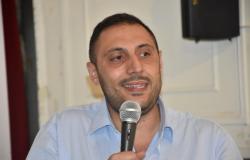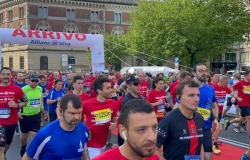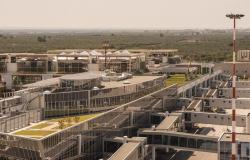Sassari. The symphony season of the “Marialisa de Carolis” Concert Authority kicked off last Wednesday, April 24th. The protagonist of the first appointment (and will also be of the second, on May 4th) is the violinist and director Massimo Quarta, recently appointed main guest director of the Institution, called at the last minute to replace an indisposed Uto Ughi, who will recover his Sassari presence in autumn (13 October the expected date). A change that we liked right away. For a very simple reason: Ughi is indeed a great name in violinism, but for some time he has been offering performances that can be defined as decidedly anchored to the past. Today, readings of the classics marked by a philological taste and with the use of performance practices called “original” (and baroque ensembles play period instruments or copies), that is, those used in the times of the composers themselves, which differ clearly depending on the period. Massimo Quarta, in reality, is not a violinist who refers to the philological school, but has specialization in the Paganini repertoire. In fact, winner of the prestigious Paganini Prize in 1991, the second Italian to obtain it (the first was Salvatore Accardo in 1958), he is still a great interpreter of the Genoese composer today. And in Sassari he performed one of the virtuosic masterpieces, “I palpiti” op.23, Introduction, theme and variations on “Di tanto palpiti” from Gioachino Rossini’s Tancredi (the two great composers were friends), drawing an ovation from the audience of the Municipality.
However, it did not go as well, and it must be said immediately, with the other two compositions on the program, both by Mozart. The concerts of the symphony season of the Ente Concerti – prelude to the autumn opera season which this year too will have two summer previews: on 28-30 June the premiere of the Italian version of “Falso betray” by Marco Tutino, with the prestigious direction of Hugo de Ana and the direction of the controversial Beatrice Venezi, and then, on 12 July, a version of Giuseppe Verdi’s Otello, reread for the performance in the Italian square – seem from this first appointment to retrace what was heard in 2023. So we wrote, in a review published in the diocesan weekly “Libertà”, that the concerts were characterized by a double proposal: a first part, overall successful, with the virtuoso dominating the scene, corresponded to a less convincing second part with the same performer who from being a soloist became exclusively a director. All this seems to repeat itself, thanks to an orchestral team that once again highlighted the usual problems, amplified by the installation of the acoustic chamber above the stage of the Teatro Comunale. A solution that on the one hand resolves a series of sonic limitations that notoriously accompany the structure of Cappuccini: the wind instruments, for example, are finally balanced and not predominant. On the other hand, critical issues are accentuated which lately seem decidedly aggravated by a poor amalgamation of the strings, in particular the violins which on Wednesday evening at times were unable to play in unison (in several passages clear discordances were also heard). Furthermore, the distance from the audience due to the covering of the orchestra pit made the sound less clear and darker.
Of the famous Concerto for violin and orchestra n. 5 in A major K219 by Wolfgang Amadeus Mozart Massimo Quarta has necessarily offered an uneven reading. His splendid mastery of performance, albeit in a purely romantic key with late nineteenth-century vibrato, did not correspond to a constant orchestral presence. The Rondeau – minuet time which is traditionally called “türkisch” (Turkish style) he convinced the public, who immediately afterwards let themselves be carried away by the enthusiasm with Paganini’s “I palpiti”. The first part of the concert ended with an excellent encore, the Wide from the Sonata for solo violin no.3 in C Major BWV 1005 by Johann Sebastian Bach.
In the second part one of Mozart’s masterpieces was on the program, one of the best-known compositions, namely Symphony no. 40 in G minor K550. This too is now performed by international symphony groups according to a philological practice (although not using period instruments). The legendary Berliner Philharmoniker are no exception and, just to clarify, last autumn they were directed by a specialist in the music of the 17th and 18th century such as the violinist Domenico Minasi (historical collaborator of Jordi Savall), who brought to the Berlin Philharmonie, and it is certainly nothing new (just think of the Mozart and Beethoven concerts of the past years with the great Nikolaus Harnoncourt or with Jean-Christophe Spinosi, just to mention two names from different generations, and before that, albeit in embryonic form, with a giant like Claudio Abbado and then with Simon Rattle), precisely this performance style that not too long ago symphony orchestras didn’t even take into consideration. A trend that unfortunately still struggles to take hold in Italy, mostly due to the laziness of musical institutions. Today it is heresy to perform, for example, Vivaldi or Bach with a symphony orchestra with late nineteenth-century instruments and a marked vibrato of the strings. Here then is the risk for a team like that of the Concert Authority, which requires vigorous adjustments depending on the repertoire and which normally accompanies singers in operas, of producing results that are not up to par. As happened the other evening with the K550 Symphony. Quarta, who conducts without a baton, showed a sustained (but correct) performance speed right from the first bars, which however clearly put the orchestra in difficulty. In short, a reading not adequately supported by a team that has once again shown its limits. It is therefore difficult to express an opinion on the quality of the performance, which to be honest did not convince us and which seemed a bit scholastic and discontinuous, especially in the well-known first movement.
Audience not for great occasions, empty gallery and large gaps in the stalls, plus some uncontrolled applause at the end of the first two movements of the Violin Concerto. And a buzz of wonder (“ah, I know it”) at the beginning of the K550 Symphony.
The next concert is scheduled, as mentioned, for next Saturday 4 May. Massimo Quarta will return to the Comunale stage in a program entirely by Tchaikovsky, of which the very famous Concerto for violin and orchestra in D major op.35 and the Symphony n.4 in F minor op.36.
LF









